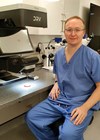Trainees
Broadening horizons in ophthalmology: crafting a varied elective experience
The elective period for medical students is a unique opportunity to immerse oneself in a field of interest. For students interested in ophthalmology, this can offer a dedicated experience for what can otherwise be quite limited through undergraduate rotations. Alongside...
Why Ophthalmology?
Ophthalmology is a medical specialty that deals with eye diseases and helps preserve vision. The ophthalmic community consists of a wide range of healthcare professionals who work together to address eye-related problems in many extraordinary ways. This article explores the...
Ophthalmology Specialty Training 2024: What's different?
The 2024 intake for ophthalmology specialty training (OST) has undergone several significant changes in its approach towards candidate selection and assessment. This article provides a comparative analysis, detailing these new measures and comparing them against the previous year's standards. Our...
How to maximise points for your ophthalmology portfolio as a medical student
Ophthalmology is an extremely popular and competitive career option, with one of the highest competition ratios at ST1 level entry (10:1 in 2023) [1]. It is also a highly rewarding speciality, involving: a mixture of medicine and surgery in a...
Attending ophthalmology conferences as a foundation trainee: an eye-opener?
The benefits of attending specialty conferences for clinicians are numerous. For example, staying up to date with the latest advancements in the field and integrating these into clinical practice. However, foundation doctors are yet to enter a training pathway and...
Burnout: ubiquitous and unavoidable?
Meriam Islam reminds us of the importance of ‘putting our oxygen mask on first’ and avoiding burnout while we progress through our careers. Burnout. It’s a term we hear a lot. What does it mean though? According to Merriam Webster,...
Immunoglobulin G4-related ophthalmic disease – what is it? (Part 2)
Part 2: Clinical presentation and treatment (see part 1 here) Introduction IgG4-related disease (IgG4-RD) is understood to have a vast clinicopathological spectrum; nearly every organ has had reported involvement. Similarly, IgG4-related ophthalmic disease (IgG4-ROD) is known to affect nearly every...
Immunoglobulin G4-related ophthalmic disease – what is it? (Part 1)
Part 1: Epidemiology, classification, radiology, histopathology and associations (see Part 2 here) In this two-part series, Li Yen Goh reviews IgG4 disease and reminds us of diagnostic challenges faced. Introduction Immunoglobulin G4 (IgG4) disease is a recently recognised idiopathic systemic...
Demystifying external trainee selected components and out of programme experiences
If you don’t know your external TSCs from your OOPC/OOPT/OOPE/OOPR, then this article is for you. Trainee selected components (TSC) are College-approved periods of training, usually ranging from six months to a year (formally ASTO) of intensive subspecialty training in...
Myopia management
With the growing prevalence of myopia at epidemic levels in some countries and increasing number of research publications on myopia control, there is a lot of controversy regarding the management of myopia. As none of them are at present available...
The first on-call
You’ve made into ophthalmic specialist training and before you know it, it’s your first on-call shift. You are expected to provide the specialist on-call service out of hours and there is a new wave of responsibility, with, let’s be honest,...
Glasgow eye department continues to disrupt ocular simulation training through novel DRV system - the first of many?
Ongoing technological developments are enabling continuous progress to be made across all aspects of medical simulation training. This is particularly true within the field of ophthalmology, where surgical training advancements have enabled the role of simulation to expand dramatically over...















